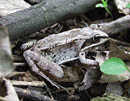
 There are many animals that survive in very cold climates. Most of them survive the cold temperatures by avoiding exposure to the extreme temperatures. They may do this by going deep underground or by hibernating in a way where their biological systems slow down long enough to survive the duration of winter. There is one frog however, that survives the coldest Alaskan winter. This frog is called the wood frog (Rana sylvatica) and is found even north of the Arctic circle.
There are many animals that survive in very cold climates. Most of them survive the cold temperatures by avoiding exposure to the extreme temperatures. They may do this by going deep underground or by hibernating in a way where their biological systems slow down long enough to survive the duration of winter. There is one frog however, that survives the coldest Alaskan winter. This frog is called the wood frog (Rana sylvatica) and is found even north of the Arctic circle.
The wood frog begins its life cycle in pretty typical fashion. Fertilized eggs are laid in ponds and lakes and the frog wanders several miles on land to hunt insects and other food sources. In the fall they do not burrow deep under ground but hunker down in moss or leaves or sandy soil. As the temperature drops below zero the frogs are literally frozen and will stay frozen for up to eight months. One organ after another freezes adjusting to the very cold temperature. The liver of the frog freezes early producing a solution of glucose as it does so. The glucose is distributed throughout the frog's body so the cells are saturated with glucose which prevents ice from forming in the cells. Two thirds of the frog’s body turns to ice which is outside the cells, with all organs frozen solid.
In the spring the frogs thaw from the inside out. The heart begins to beat — although no one knows what makes it start up. Other organs beginning with the liver and including the brain kick into gear one after the other, and glucose levels return to normal. The frogs then hop back into the pond or lake for reproductive purposes and the process is repeated.
Researchers are hoping that understanding this frog will lead to ways of freezing and thawing human organs for transplant purposes without damaging them. Without incredible design and planning, life could not exist in such alien environments as northern Alaska. The remarkable chemistry of wood frogs is another testimony to the fact that throughout the earth we can see design in all kinds of life forms — even what one researcher calls a “frogcicle.” Source: Alaska magazine, October 2012, page 28.
Picture credits:
http://en.wikipedia.org/wiki/File:Ranasylvatica.JPG
